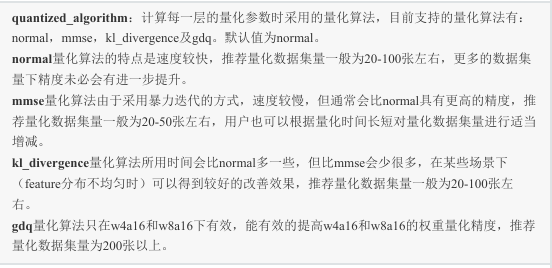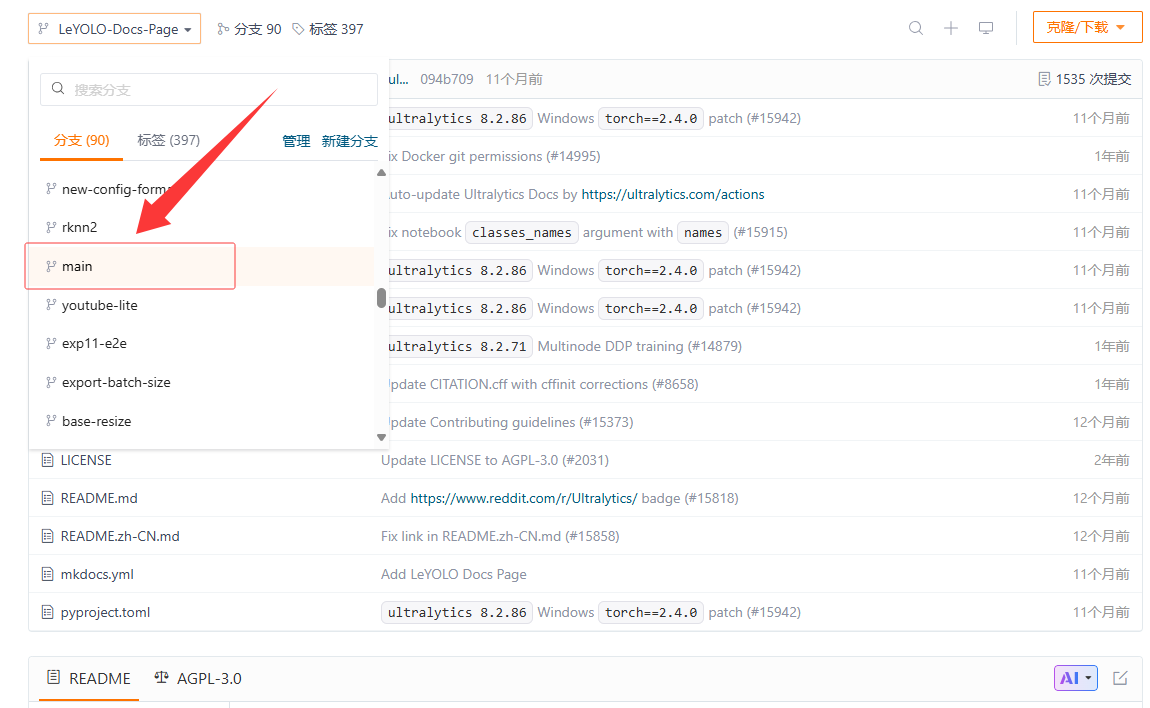RK3588在YOLO12(seg/pose/obb)推理任务中的加速方法
问题背景
在使用RK3588进行YOLO12(seg/pose/obb)推理任务中,推理速度过慢,平均在2hz左右。无法在边缘端的场景中应用落地。
原因分析
RK3588的CPU是6核,在进行实例分割、姿态估计等需要大量后处理计算的任务时,计算资源不够。
如果需要优化,方向大致是压缩模型推理时间、改进后处理部分计算。显然前者较为轻松,方法就是量化/降低分辨率。后者要将后处理部分的计算优化,最有可能的就是改用c语言实现。
实际测试
-
量化:主要是使用int8量化。
cd python python convert.py <onnx_model> <TARGET_PLATFORM> <dtype(optional)> <output_rknn_path(optional)># such as: python convert.py ../model/yolo11n.onnx rk3588 i8 rk3588 # output model will be saved as ../model/yolo11.rknnRKNN量化方法介绍

-
减低分辨率:这个分辨率是指推理时的分辨率,默认640x640;可以在转换onnx模型时将其降为更低的分辨率,例如,480x480;
-
在模型转换之前一定要选择main分支代码:

-
imgsz改为更小的分辨率再次转换即可。
# Ultralytics YOLO 🚀, AGPL-3.0 license # Default training settings and hyperparameters for medium-augmentation COCO trainingtask: detect # (str) YOLO task, i.e. detect, segment, classify, pose mode: train # (str) YOLO mode, i.e. train, val, predict, export, track, benchmark# Train settings ------------------------------------------------------------------------------------------------------- model: # (str, optional) path to model file, i.e. yolov8n.pt, yolov8n.yaml data: # (str, optional) path to data file, i.e. coco8.yaml epochs: 100 # (int) number of epochs to train for time: # (float, optional) number of hours to train for, overrides epochs if supplied patience: 100 # (int) epochs to wait for no observable improvement for early stopping of training batch: 16 # (int) number of images per batch (-1 for AutoBatch) imgsz: 640 # (int | list) input images size as int for train and val modes, or list[h,w] for predict and export modes save: True # (bool) save train checkpoints and predict results save_period: -1 # (int) Save checkpoint every x epochs (disabled if < 1) cache: False # (bool) True/ram, disk or False. Use cache for data loading device: # (int | str | list, optional) device to run on, i.e. cuda device=0 or device=0,1,2,3 or device=cpu workers: 8 # (int) number of worker threads for data loading (per RANK if DDP) project: # (str, optional) project name name: # (str, optional) experiment name, results saved to 'project/name' directory exist_ok: False # (bool) whether to overwrite existing experiment pretrained: True # (bool | str) whether to use a pretrained model (bool) or a model to load weights from (str) optimizer: auto # (str) optimizer to use, choices=[SGD, Adam, Adamax, AdamW, NAdam, RAdam, RMSProp, auto] verbose: True # (bool) whether to print verbose output seed: 0 # (int) random seed for reproducibility deterministic: True # (bool) whether to enable deterministic mode single_cls: False # (bool) train multi-class data as single-class rect: False # (bool) rectangular training if mode='train' or rectangular validation if mode='val' cos_lr: False # (bool) use cosine learning rate scheduler close_mosaic: 10 # (int) disable mosaic augmentation for final epochs (0 to disable) resume: False # (bool) resume training from last checkpoint amp: True # (bool) Automatic Mixed Precision (AMP) training, choices=[True, False], True runs AMP check fraction: 1.0 # (float) dataset fraction to train on (default is 1.0, all images in train set) profile: False # (bool) profile ONNX and TensorRT speeds during training for loggers freeze: None # (int | list, optional) freeze first n layers, or freeze list of layer indices during training multi_scale: False # (bool) Whether to use multiscale during training # Segmentation overlap_mask: True # (bool) masks should overlap during training (segment train only) mask_ratio: 4 # (int) mask downsample ratio (segment train only) # Classification dropout: 0.0 # (float) use dropout regularization (classify train only)# Val/Test settings ---------------------------------------------------------------------------------------------------- val: True # (bool) validate/test during training split: val # (str) dataset split to use for validation, i.e. 'val', 'test' or 'train' save_json: False # (bool) save results to JSON file save_hybrid: False # (bool) save hybrid version of labels (labels + additional predictions) conf: # (float, optional) object confidence threshold for detection (default 0.25 predict, 0.001 val) iou: 0.7 # (float) intersection over union (IoU) threshold for NMS max_det: 300 # (int) maximum number of detections per image half: False # (bool) use half precision (FP16) dnn: False # (bool) use OpenCV DNN for ONNX inference plots: True # (bool) save plots and images during train/val# Predict settings ----------------------------------------------------------------------------------------------------- source: # (str, optional) source directory for images or videos vid_stride: 1 # (int) video frame-rate stride stream_buffer: False # (bool) buffer all streaming frames (True) or return the most recent frame (False) visualize: False # (bool) visualize model features augment: False # (bool) apply image augmentation to prediction sources agnostic_nms: False # (bool) class-agnostic NMS classes: # (int | list[int], optional) filter results by class, i.e. classes=0, or classes=[0,2,3] retina_masks: False # (bool) use high-resolution segmentation masks embed: # (list[int], optional) return feature vectors/embeddings from given layers# Visualize settings --------------------------------------------------------------------------------------------------- show: False # (bool) show predicted images and videos if environment allows save_frames: False # (bool) save predicted individual video frames save_txt: False # (bool) save results as .txt file save_conf: False # (bool) save results with confidence scores save_crop: False # (bool) save cropped images with results show_labels: True # (bool) show prediction labels, i.e. 'person' show_conf: True # (bool) show prediction confidence, i.e. '0.99' show_boxes: True # (bool) show prediction boxes line_width: # (int, optional) line width of the bounding boxes. Scaled to image size if None.# Export settings ------------------------------------------------------------------------------------------------------ format: torchscript # (str) format to export to, choices at https://docs.ultralytics.com/modes/export/#export-formats keras: False # (bool) use Kera=s optimize: False # (bool) TorchScript: optimize for mobile int8: False # (bool) CoreML/TF INT8 quantization dynamic: False # (bool) ONNX/TF/TensorRT: dynamic axes simplify: False # (bool) ONNX: simplify model using `onnxslim` opset: # (int, optional) ONNX: opset version workspace: 4 # (int) TensorRT: workspace size (GB) nms: False # (bool) CoreML: add NMS# Hyperparameters ------------------------------------------------------------------------------------------------------ lr0: 0.01 # (float) initial learning rate (i.e. SGD=1E-2, Adam=1E-3) lrf: 0.01 # (float) final learning rate (lr0 * lrf) momentum: 0.937 # (float) SGD momentum/Adam beta1 weight_decay: 0.0005 # (float) optimizer weight decay 5e-4 warmup_epochs: 3.0 # (float) warmup epochs (fractions ok) warmup_momentum: 0.8 # (float) warmup initial momentum warmup_bias_lr: 0.1 # (float) warmup initial bias lr box: 7.5 # (float) box loss gain cls: 0.5 # (float) cls loss gain (scale with pixels) dfl: 1.5 # (float) dfl loss gain pose: 12.0 # (float) pose loss gain kobj: 1.0 # (float) keypoint obj loss gain label_smoothing: 0.0 # (float) label smoothing (fraction) nbs: 64 # (int) nominal batch size hsv_h: 0.015 # (float) image HSV-Hue augmentation (fraction) hsv_s: 0.7 # (float) image HSV-Saturation augmentation (fraction) hsv_v: 0.4 # (float) image HSV-Value augmentation (fraction) degrees: 0.0 # (float) image rotation (+/- deg) translate: 0.1 # (float) image translation (+/- fraction) scale: 0.5 # (float) image scale (+/- gain) shear: 0.0 # (float) image shear (+/- deg) perspective: 0.0 # (float) image perspective (+/- fraction), range 0-0.001 flipud: 0.0 # (float) image flip up-down (probability) fliplr: 0.5 # (float) image flip left-right (probability) bgr: 0.0 # (float) image channel BGR (probability) mosaic: 1.0 # (float) image mosaic (probability) mixup: 0.0 # (float) image mixup (probability) copy_paste: 0.0 # (float) segment copy-paste (probability) auto_augment: randaugment # (str) auto augmentation policy for classification (randaugment, autoaugment, augmix) erasing: 0.4 # (float) probability of random erasing during classification training (0-0.9), 0 means no erasing, must be less than 1.0. crop_fraction: 1.0 # (float) image crop fraction for classification (0.1-1), 1.0 means no crop, must be greater than 0.# Custom config.yaml --------------------------------------------------------------------------------------------------- cfg: # (str, optional) for overriding defaults.yaml# Tracker settings ------------------------------------------------------------------------------------------------------ tracker: botsort.yaml # (str) tracker type, choices=[botsort.yaml, bytetrack.yaml]
- 使用C语言写后处理部分(速度提升不如前两者)
